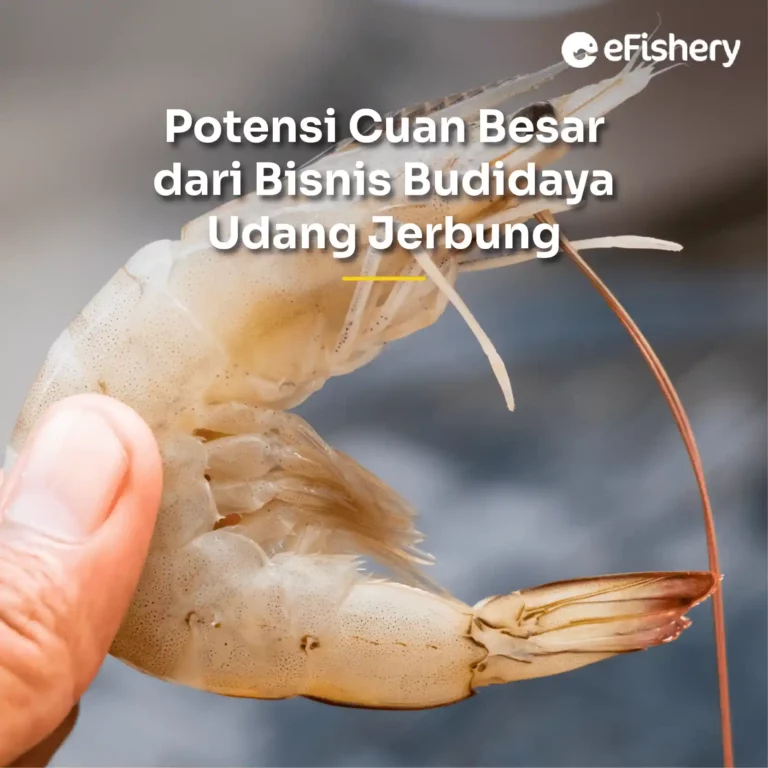Artikel Ini Telah Direview Oleh:

Sangga Sulistyo
Praktisi Aquaculture
Currently, importing vannamei shrimp is quite difficult because of the high price. Many shrimp farmers are taking advantage of this gap by developing a shrimp business. The potential for the shrimp farming business is not inferior to that of vannamei shrimp, considering that the two types of shrimp have characteristics and meat quality that are not much different.
The reason why the jerbung and vannamei shrimp have almost the same characteristics is the classification of the jerbung and vannamei shrimp which are still in the same family, namely the Penaidea or Penaeus family.
Jerbung shrimp also has many nicknames from various countries, such as red feet in Malaysia, white prawns in Hong Kong, and banana prawns in Australia. In Indonesia, shrimp jerbung itself has several names, namely popet shrimp, peci shrimp, deer shrimp, kelong shrimp, pate shrimp, and sharp shrimp.
The potential for the jerbung shrimp business is as tempting as vannamei shrimp because this type of shrimp has high economic value. This is because the jerbung shrimp has delicious meat and high nutritional content.
Let's find out more about Jerbung Shrimp and its business potential!
Get to know Jerbung Shrimp
Basically, the morphology and shape of the jerbung shrimp is almost the same as most shrimp. But specifically, the characteristics of the jerbung shrimp are the yellowish-white body color covered with green and brown patterns/spots, with the tip of the tail and legs red, and a dark red line on the antennae.
Jerbung shrimp has a body with a length of about 7-8 cm, while the length from head to back is only 3-4 cm. However, the female jerbung shrimp has a maximum size of 2.4 cm with a maximum body weight of 40 grams.
The jerbung shrimp has 5-8 rostrum teeth, 2-5 of the rostrum teeth are at the bottom. If you look more closely, you will see compound eyes on the lower part of the base of the rostrum.
The jerbung shrimp has 5 pairs of peripods or legs of the jerbung shrimp, three pairs of which have pincers. In addition, the jerbung shrimp also has 5 pairs of peliopods or swimming legs on the abdomen. These swimming legs are on every segment of the body of the jerbung shrimp.
There are actually six pairs of peliopods, but the last swimming legs fuse and change shape into a fantail, at the end of which it resembles a telson or tail.
Jerbung Shrimp Business Potential
Jerbung shrimp can be found in various territorial waters of Indonesia and the world. In Indonesia alone, jerbung shrimp can be found in the waters of Bengkulu, Cirebon, Cilacap, the Lombok Strait and the Arafura waters. As for the Indo-West Pacific waters, these shrimp can be found in the waters of Hong Kong, the Philippines, Papua New Guinea, the Persian Gulf, New Caledonia and Northern Australia.
However, of all these waters, Indonesia is claimed to be the country that produces the most jerbung shrimp because its production can be more than 65 thousand tons per year. In 2001 alone, Indonesia produced more than 25 thousand tons of shrimp caught from its natural waters. In 2016, this figure increased to 100 thousand tons, of which 20 thousand tons came from the shrimp farming.
The water areas that produce the most jerbung shrimp are Bengkulu, East Lampung, Cilacap, Cirebon, Lombok Strait, South Sulawesi, and the Arafura waters. For example, in the waters of East Lampung, farmers are able to bring home as many as 5-10 kg of jerbung shrimp. The price offered by the middlemen at that time could reach 100,000-150,000 thousand per kg.
Because it is considered to have a meat content and taste similar to vannamei shrimp, Indonesia has begun to reduce imports of vannamei shrimp and replace them with jerbung shrimp which are obtained at lower prices. So, it can be said that the potential for the Jerbung Shrimp business is currently quite attractive because there is a lot of demand every year, but there are still relatively few shrimp farmers.
Advantages of Jerbung Shrimp
The advantages of Jerbung Shrimp compared to other types of shrimp are:
- Number Survival Rate (SR) is relatively high, which is more than 80%
- The process of raising the larvae is easy, but the growth rate is still fast
- The cost of maintaining the broodstock of the jerbung shrimp is relatively low
- The maturity level of the broodstock gonads is fast and spawning can be done using pond-cultivated shrimp broodstock
- Shrimp size variability is low
- Salinity tolerance level is greater
- Stable market demand
Starting Jerbung Shrimp Cultivation
The first step to cultivating jerbung shrimp is to prepare sufficient feed because jerbung shrimp have more aggressive characteristics than tiger prawns and are more greedy than vannamei shrimp.
Jerbung shrimp feed is detritus. Farmers need to provide sufficient feed. Jerbung shrimp feed is stocked during the day, because the Jerbung shrimp only look for food during the day.
At night, the shrimp actively swim. When the amount of feed stocked is insufficient, there is the potential for cannibalism or eating of the same sex to the shrimp, causing a high risk of mass mortality.
After feeding, you also need to consider the location of the shrimp ponds. Jerbung shrimp live in bays that have large river flows or on the seabed with a depth of 10-45 m.
Jerbung shrimp like to swim on the seabed rather than on the surface of the water. Jerbung shrimp will live in the sea as far as 90-130 km from the coast or in the sea with a depth of 8-80 meters above sea level. Adult jerbung shrimp will usually be easier to find around river mouths.
Jerbung shrimp is a type of heterosexual animal. To distinguish the sex of male and female shrimp, you can pay attention to their reproductive organs. Male shrimp have reproductive organs consisting of testes, vasa differentia, petasma, and masculine appendix. Petasma is on the swimming legs, while the genital opening is around the fourth and fifth legs.
The female jerbung shrimp reproductive organs consist of a pair of ovaries, genital parts, and thelycum. Thelycum is between the fourth and fifth street legs. The ovary is the female shrimp ovary whose role is to produce eggs. The shape of the ovary extends to the tail.
Usually, the habitat of the shrimp when spawning is in the sea. The female parent is able to produce as many as 100,000-1,000,000 eggs when in its natural habitat, whereas hatchery Jerbung shrimp can only produce as many as 100,000-400,000 eggs.
Get Tips for Succeeding Jerbung Shrimp Cultivation at eFarm!
Need Help Regarding Shrimp Cultivation Business?
Fill in your personal data in the following form. Our team will immediately contact you via the number cellphone attached. Make sure the data entered is correct.
Even if you already know the information about Jerbung Shrimp and how to cultivate it, you might encounter certain obstacles while carrying out the shrimp farming business. At that moment, a trusted source of information becomes invaluable. However, you don't need to worry or be confused, because eFarm can provide a solution to the constraints of shrimp cultivation.
eFarm is an application for farmers to cultivate shrimp. eFarm dilengkapi dengan berbagai fitur, termasuk fitur Cultivation Consultation yang bisa diakses secara gratis. Melalui fitur ini, Bapak/Ibu bisa berkonsultasi dengan para ahli Akuakultur sehingga Bapak/Ibu bisa mendapatkan langkah penanganan yang tepat dari ahlinya.
come on, downloads eFarm and take advantage of its various features!

Sangga Sulistyo - Praktisi Aquaculture
Sangga adalah praktisi Aquaculture yang memulai karirnya pada tahun 2003 dan sekarang menjadi Technical Support Manager eFishery untuk seluruh wilayah Indonesia
Questions Regarding the Business Potential of Jerbung Shrimp
The potential for the Jerbung Shrimp business is currently quite wide open because the demand for Jerbung Shrimp is increasing every year, but the farmers who cultivate Jerbung Shrimp are still relatively few.
The advantage of jerbung shrimp is numbers Survival Rate (SR) is high, the process of rearing the larvae is easy, the growth rate is fast, the variability in shrimp size is low, the temperature and salinity tolerance levels are greater, and market demand tends to be stable.
